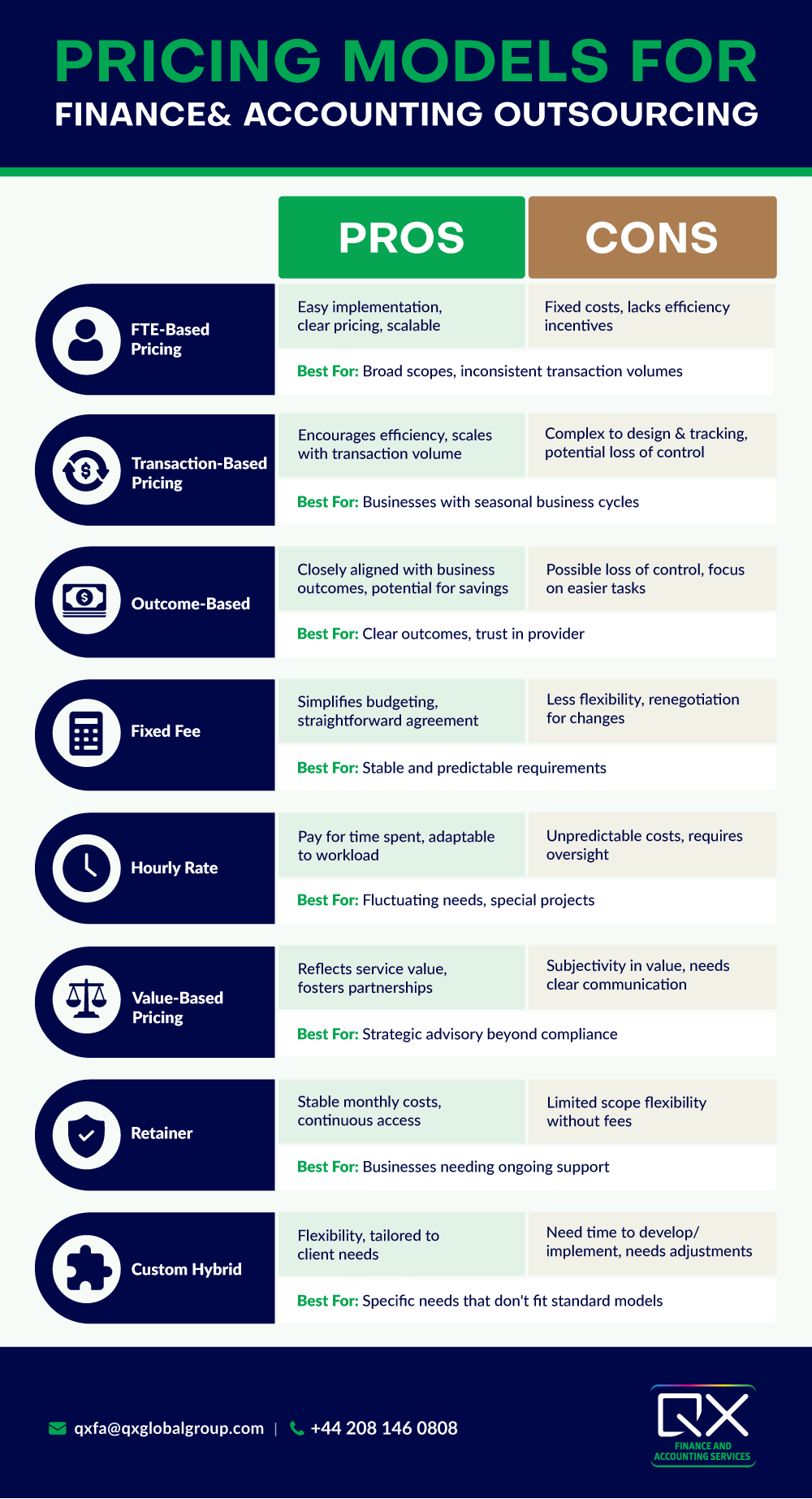Topics: Finance & Accounting Outsourcing
Posted on March 20, 2024
Written By Miyani Lourembam

Think about the last time you compared two restaurant menus. The cheapest dish might have looked tempting, but the real decision came down to value: what you got for the price. Outsourcing works in a very similar way. It is not just about finding the lowest cost, it is about choosing a model that truly fits the way your business operates.
That is why outsourcing pricing models matter so much. They shape how the partnership works, how risks are shared, and how value is created. In the world of finance, the impact is even bigger. The right finance and accounting pricing models can bring cost predictability, smoother reporting cycles, and stronger compliance. The wrong choice can lead to inefficiencies, hidden costs, and frustration on both sides.
In this blog, we will walk through the most common models, explain how each one works, and show what CFOs should keep in mind when deciding which approach delivers the best long-term value.
The way you pay for outsourcing shapes more than just the invoice at the end of the month. In finance and accounting, the pricing model sets the tone for the entire partnership. Get it right, and you have cost clarity, smoother processes, and a provider that feels in sync with your goals. Get it wrong, and you end up with surprises, frustration, and numbers that don’t quite add up.
So why do finance and accounting pricing models matter so much?
In short, pricing models are not a detail to be ticked off at the contract stage. They are a lever for shaping how outsourcing works day to day, and how much value your business actually gets from it.
It’s not just about finding the lowest bidder; it’s about understanding which pricing structure aligns with your company’s goals, workload, and financial strategies. The selected pricing model can significantly influence the scalability, quality, and sustainability of the services provided, making it a key factor in selecting a service provider that will deliver value beyond just cost reduction.
When it comes to outsourcing, the pricing model you choose shapes the partnership. It defines not just the cost, but also the flexibility, transparency, and level of control you get. Here are the most common models used in Finance and Accounting outsourcing:
You pay for a dedicated resource, measured in “full-time equivalents” (FTEs). It is straightforward: the provider assigns staff to your processes, and you pay a fixed monthly fee for each. This model works well if you want steady capacity and predictable costs, but it may feel less flexible when workloads rise or fall.
Here, you pay per transaction or activity, such as the number of invoices processed or reconciliations completed. It links cost directly to volume. The benefit is clear alignment between activity and spend, but forecasting costs can be tricky if transaction volumes fluctuate widely.
This approach ties fees to results, not activity. For example, payments might depend on reducing days sales outstanding or achieving faster month-end closes. It motivates the provider to deliver measurable business outcomes. The challenge is agreeing on fair metrics and tracking them consistently.
A set fee is agreed upfront for defined services, regardless of time or effort. It offers budget certainty and works well when the scope is stable. But if requirements change or expand, the model may need renegotiation.
You pay based on the hours worked by the provider’s team. It is flexible and easy to understand, especially for short-term projects or irregular workloads. On the downside, costs can climb quickly if tasks take longer than expected.
Instead of billing for time or transactions, the price reflects the value delivered to your business. For example, fees might relate to cost savings, risk reduction, or efficiency gains. It aligns incentives closely, but requires strong trust and clear measurement between client and provider.
A monthly or quarterly retainer secures ongoing access to services within an agreed scope. It balances predictability with flexibility, as businesses know what they are paying while still accessing expertise as needed.
Many companies blend elements of different models to suit their needs. A hybrid might combine FTE pricing for steady tasks, transaction-based pricing for variable workloads, and outcome-based pricing for strategic goals. This tailored approach offers balance but requires careful design and governance.
Today, we will provide a comprehensive infographic scrutinising various pricing strategies within the finance and accounting outsourcing industry. By delving into each model’s pros, cons, and best-use scenarios, we provide insights that allow you to identify a model that cuts costs and enhances scalability, quality, and service sustainability.
Understanding these pricing models is essential for making an informed choice, ensuring that the value delivered by your service provider is well-aligned with your business’s specific requirements for flexibility, scalability, or predictability.

Not all finance and accounting outsourcing pricing models work in the same way. Some look similar on the surface but have important differences once you dig in. Here is a straightforward look at how the most common ones compare:
Both are about paying for people, but the structure changes the outcome:
Each offers stability, yet the way they are applied is not the same:
Both link pricing to performance, but the focus is different:
Understanding these differences helps finance leaders decide which approach best fits their priorities, whether that is stability, flexibility, or linking cost directly to business value.
Technology has changed the way companies look at finance and accounting outsourcing. As automation, AI, and cloud platforms replace repetitive manual work, traditional billing models start to feel outdated.
For CFOs, the impact is clear. The cost of outsourcing accounting services is no longer just about labour hours. It is about how effectively technology helps deliver efficiency, accuracy, and insight.
The future of outsourced finance is closely tied to the way services are priced. As organisations push for more transparency and measurable outcomes, pricing models are shifting.
For finance leaders, pricing choices are becoming a strategic lever. The right model does more than reduce cost. It supports growth, agility, and trust in the value of finance and accounting outsourcing.
Each finance and accounting pricing model is intricately crafted, ranging from models that assure fixed costs to those that adapt to business performance. This ensures that every organisation can find an outsourcing partner that resonates with their financial management style and business evolution.
Finance and accounting pricing models refer to various strategies used to determine the cost of financial services provided by firms. These models can include fixed fees, transaction-based pricing, value-based pricing, and FTE (Full-Time Equivalent) pricing, each tailored to meet different client needs and service complexities.
In the FTE pricing model for finance and accounting, clients are charged based on the number of full-time equivalent employees dedicated to their account. This model provides transparency and is often used in scenarios where the scope of work is extensive and predictable, making it easier for businesses to budget and plan for costs.
When comparing outsourcing pricing models for finance services, consider factors such as the complexity of tasks, the predictability of the workload, cost variability, and the level of expertise required. Common models include transaction-based pricing, FTE pricing, and project-based pricing, each offering different advantages depending on your specific needs and financial management strategies.
An FTE model charges a set fee per full-time resource, giving predictable costs. Transaction-based pricing links fees to activity levels, such as invoices processed, which makes spend rise or fall with volume.
Transaction-based and hybrid outsourcing pricing models usually scale best. They flex with activity levels, making them ideal for companies experiencing rapid growth or seasonal swings.
For smaller firms, fixed fee or transaction-based models often deliver the best balance. They keep outsourced accounting services pricing transparent while avoiding surprises in monthly costs.
Yes. Hybrid models combine stability with flexibility, which fits industries where volumes shift or processes vary. Hospitality, real estate, and other complex sectors benefit from this tailored approach.
QX Global Group offers a full range of finance and accounting outsourcing options. From FTE and fixed fee to outcome-based and hybrid structures, pricing is tailored to each client’s goals, ensuring flexibility, scalability, and value.
Originally published Mar 20, 2024 07:03:21, updated Sep 18 2025
Topics: Finance & Accounting Outsourcing